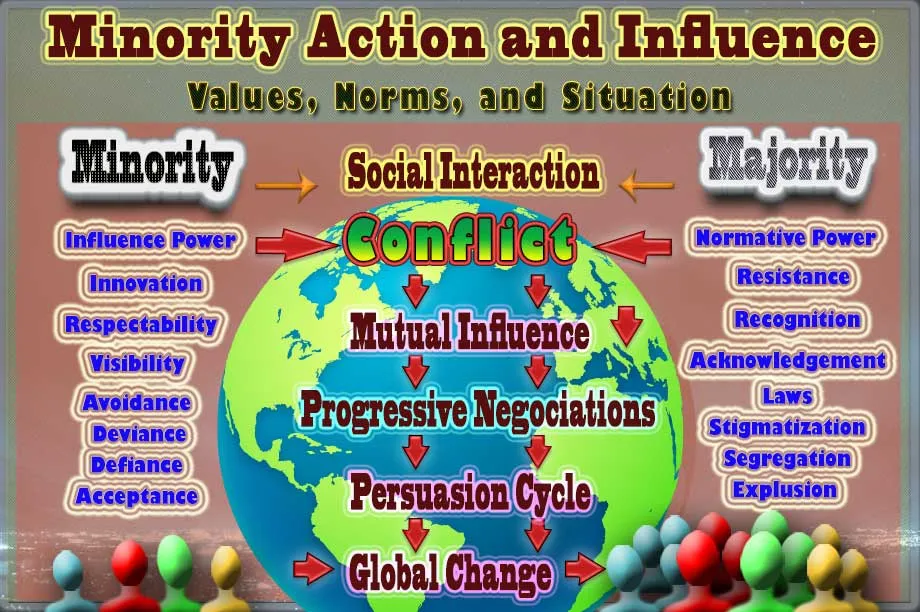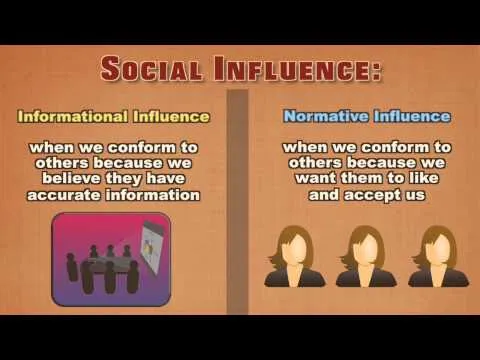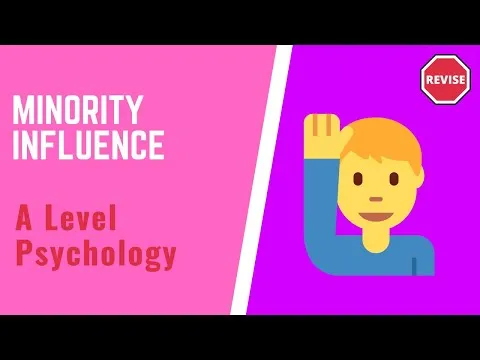Social Reality: Violence, Power, and Change
A Social Change - Part 2 - Minorities as Social Influence
"Minorities can turn into Majorities" - charlie777pt
Introduction
Majorities always use normative social influence, while minorities use information in cognitive structured messages and persuasion.
Minority views and positions can change majority attitudes and behaviors to accept a benefiting alternative view.
1 - How do Minorities act
Minorities' actions and influence generate a social conflict with the majority that will express a resistance to the introduction of innovative perspectives about taking actions or positions.
"Almost always, the creative dedicated minority has made the world better" - Martin Luther KingThe conflict will generate reactions that make the majority acknowledging the existence of the minority with the capacity to influence, creating a kind of mechanism of negotiations, implicitly or explicitly, as a system of persuasion.
The minority forces a proposal for alternatives, persuading the majority to accept the innovation , using negotiations as the main dimension of the societal process of influence.
In an experiment, Moscovici showed that individuals with consistency can have more influence over the people that is less consistent no matter if they where in the majority or minority group.
The consistent individuals in the minority group have more influence in their peers, to change behaviors and become strong allies, but in the majority group, these phenomena do not happen in such a deep way.
In a later experience Moscovici and others isolated 3 important elements of minority influence:
a) - People in disagreement tend to show their points of view, but they are ready to negotiate.
b)- Consistent minorities have strong ways to act on the discrepancies to reduce them and get agreement and consensus from the majority.
c)- Minority influence is more based on sharing cognitions then from its minor position.
The minority role has its strength in the consistency of the alternative views of reality.

2 - What makes Minority influences
"Even if you are a minority of one, the truth is the truth." - Mahatma Gandhi
The influence of minorities is sustained in two aspects, on one side the behavioral or cognitive approach and the social context.
2.1- The behavioral or cognitive style
Moscovici defined the behavioral or cognitive style, as the intentional verbal and nonverbal signs, expressing the present situation and the desired one in the future, showing the desires, trends, and orientations of the people emanating it.
He pointed out the two levels of behavioral style, the instrumental giving evaluative information about the object, and the symbolic informing the individual position in relation to the object of change.
He also found out 4 behavioral styles that influence the majority:
- Investment
A strong involvement in the defense of our social positions is based in the compromises, convictions and the undertaken risks, whose perseverance to resist the initial unacceptance, creating admiration and a big visibility, even in the majority that reject the demands - Autonomy
Autonomy has two aspects, the independence(freedom of choice and truth without veils) and the reasoning objectivity and attitudes(use rationality, honesty, and self-trust) - Equity
Equity is about openness and tolerance against rigidity and unacceptance to unblock conflicts and disagreements pushing the majority to accept the new alternative. - Consistency
For Moscovici consistency is the main factor of the minority influence by coherence and conviction without gaps between our words and our acts, consubstantiated with a firm attitude against any opposition
Minorities should also maintain 3 fundamental conditions to be effective:
- Intentions must be equal to the significance of the actions and behaviors.
- The signs must be reiterated to avoid others misinterpretations of the behaviors.
- During interactions, the behaviors can't variate and must be corrected in case it happens.
Consistency as two forms the Diachronic (persistent over time when the majority do not modify its positions), and Synchronic (the strength of cohesion between members).
"The minority yields to the majority!" - Deng Xiaoping
2.2 - Social Context
Social context has opportunities and constraints to the efficacy on minority's influences in collective action and change.
2.2.1- The Pressure
Action efficiency and influence besides being connected to peoples traits of consistency can also suffer the influence of degrees of pressure that can contain it.
Minorities' influences depend a lot on the group cohesiveness maintaining the influence even if there is less consistency, attracting the majority to approach the minor group.
Any attitude change at the individual level of any member of the majority that accepts the innovation reinforces the strength and cohesion of the minority.
"The minority is sometimes right; the majority always wrong." - George Bernard Shaw2.2.2 - Social Norms
Social Interactions are susceptible to be influenced by values, social representations and norms.
For Moscovici perceptions and thoughts are influenced by three kinds of norms:
a) - Objectivity - a regulatory kind of thinking with the need to feed on exact information.
b) - Preference - based on our feeling and reasoning about the diversity of ideas and tastes on people.
c) - Originality - a way of interpreting the function of the innovation in events of reality.
Minority Groups have types of conducts in the relation with the majorities like avoidance, deviance, defiance or acceptance.
Majority Groups have a typical response to Minorities, like the rule of laws, stigmatization, segregation, exclusion, xenophobia or gender
"What characterizes a member of a minority group is that he is forced to see himself as both exceptional and insignificant, marvelous and awful, good and evil" - Norman MailerIn part 1 of this series about Social Change we have seen what is a minority and how it can influence societal change, and in part 2 we talked about the way minorities act and change the majorities, to present in part 3 the social change of groups to finish in part 4 with the exciting subject of the actual minorities of the blockchain and the philosophy of decentralization.
Videos:
Social Influence: Conformity and the Normative Influence

As Psychology - Minority Influence

Last posts in this series on Social Reality: Violence, Power and Change
Introduction:
Social Reality: Violence, Power and ChangeA - Violence:
An Introduction to ViolenceThe Concepts of Violence, Aggression, and Aggressiveness
The Theories on Violence
The influencers of Violence -Part One - Culture and Social Context
The influencers of Violence -Part Two - Social , Cognitive and Environmental Factors
The ascend of Today's Violence
B -Power:
What is Power? - IntroductionThe Nature of PowerThe Dynamics of Power:
- Part 1 - The Legitimacy of Authority
- Part 2 - The Models of Leadership
- Part 3 - Characteristics of Leadership
- Part 4 - The Relation in Leadership
- Part 5 - Decision-making and Leadership
- Part 1- Philosophical Rally on the Matrix of Power
- Part 2 - Deprivation
- Part 3- Submission
- Part 4- Corruption
- Part 5 - Resistance
- Part 6 - Power in Cyberspace
C - Change:
Change and CultureThe Theories and Concepts of Change
Factors determining ChangeThe Ways of ChangeA Social Change
- Part 1 - Innovative Change by Minorities
- Part 2 -Minorities as Social Influence - this post
Articles from the next series of posts about Social Reality, Violence, Power and Change:
C - Change:(cont.)
A Social Change- Part 3 - Minorities as Social Change
- Part 4 - The minority of Decentralization and the Blockchain
References consulted:
Les concepts fondamentaux de la psychologie sociale - Gustave-Nicolas Fischer
La psychologie sociale - Gustave-Nicolas Fischer
The social-violence dynamics, Power, change - Gustave-Nicolas Fischer, Planeta / ISPA, 1980
Gustave-Nicolas Fischer is Professor of Psychology and Director of the Psychology Laboratory at the University of Metz.
French, J. R. P., and Raven, B.H. (1959). The bases of social Power.
Raven, B. H. and Rubin, J. Z. (1976). Social psychology: People in groups
Castel, R. The metamorphoses of the social question. Voices, 1998.
Moscovici, S. (1976). Social influence and social change. London: Academic Press
Michel Foucault, Discipline and Punish: The Birth of the Prison
Festinger, L. (1954). A theory of social comparison processes.
French, J. R. P., Morrison, H. W., and Levinger, G. (1960). Coercive Power and forces affecting conformity
Dahl, R.A. (1957), The Concept of Power.
Giddens, Anthony, Capitalism and Modern Social Theory: An Analysis of the Writings of Marx, Durkheim and Max Weber, 1971.
Grabb, Edward G., Theories of Social Inequality: Classical and Contemporary Perspectives,1990.
Weber, Max, Economy and Society: An Outline of Interpretive Sociology,1968.
Lewin, K. (1948) ‘Action Research and Minority Problems’, in G.W. Lewin (ed.),Researching Social Conflicts , New York: Harper and Row
Parsons, T. (1966). Societies: Evolutionary and comparative perspectives.
Levy, A. (1986) Second-order planned change: Definition and conceptualization, Organisational Dynamics
Watzlawick, P., Weakland, J.H., Fisch, R. (1974) Change: Principles of Problem Formation and Problem Resolution. New York, Norton.